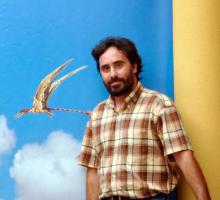The oldest definitive docodontan from central East Greenland sheds light on the origin of the clade
- Citation:
- Patrocínio, S., Panciroli E., Rotatori F. M., Mateus O., Milàn J., Clemmensen L. B., & Crespo V. D. (2025). The oldest definitive docodontan from central East Greenland sheds light on the origin of the clade. Papers in Palaeontology. 11, e70022., Number 3
Abstract:
ABSTRACT The first mammaliaforms emerged in the Late Triassic, but their exact origins remain unclear due to the scarcity of fossils from this period. One of the earliest diverging mammaliaform groups, the order Docodonta, became unusually ecomorphologically diverse compared with other early mammals, and this may be connected to the possession of complex molar cusp morphology. The specimen described here, found in the Rhætelv Formation of the Kap Stewart Group (Rhaetian–Sinemurian) of central East Greenland, provides novel information on docodontan origins and evolution, as well as key biogeographic insights into early mammal dispersal. Nujalikodon cassiopeiae gen. et sp. nov. is the first mammaliaform found in the Rhætelv Formation, and is likely to be Early Jurassic (Hettangian) in age. Comprising an incomplete dentary with a single preserved molar, it was visualized using micro-computed tomography; the molar bears similarities to the putative early docodontan Delsatia, and docodontan Dobunnodon. Phylogenetic analysis places Nujalikodon cassiopeiae as a basal member of Docodonta or a close sister taxon, making it one of the oldest definitive docodontans and pushing the origin of the group back to at least the Early Jurassic. It provides insights into the development of docodontan dental complexity, a key factor in their ecological diversification during the Middle to Late Jurassic. Its presence in Greenland supports the hypothesis that docodontans originated in the region now comprising Europe and Greenland before dispersing across the rest of Laurasia.
Notes:
e70022 PALA-10-24-5892-OA.R2
